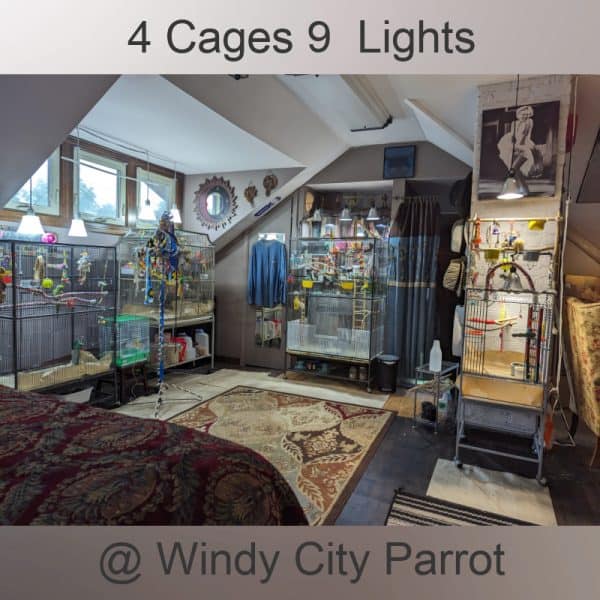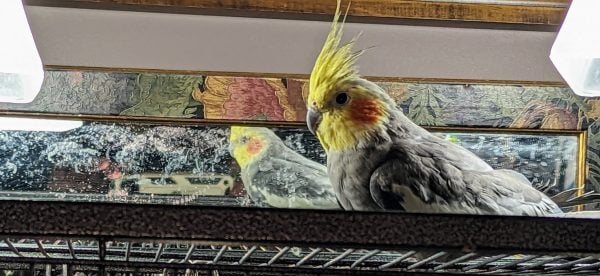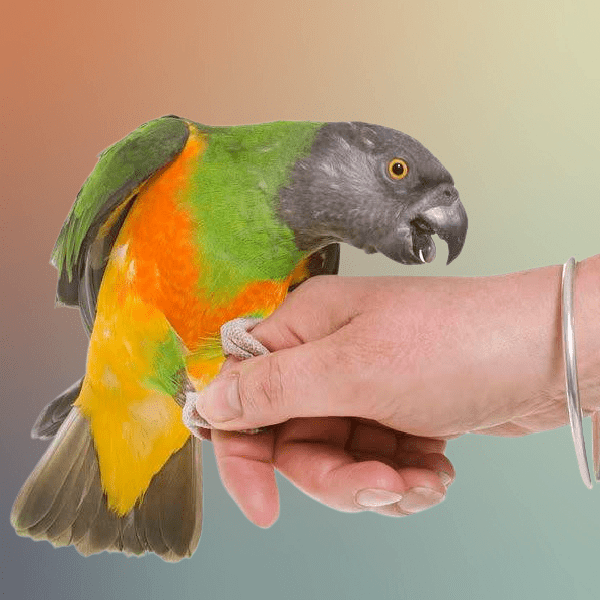
What Exactly is Your Bird Thinking ~ Part 1
Last Updated on by Mitch Rezman
We operate Windy City Parrot and our social stores from a large historic (1928) “bungalow.”
About 20 years ago the building suffered a fire that was extinguished by the Lowell volunteer fire department 3 minutes away by a fire truck.
The blaze started in the basement.
When all the repairs were done they painted the entire basement white including the ceiling making it an ideal shop for a tool guy like me.
The prior tenant was an attorney who treated the first floor like an attorney’s office with a reception window and raised counter.
The interior walls are insulated so sound can not pass from room to room.
Having the kitchen right there Is a bonus so that we can have lunch prepare dinner and continue working without a beat.
Commercial racking in the 3 conference rooms and a vintage shop up front.
Upstairs is one large “attic” shaped space.
That is where we keep our 10 birds in 4 large cages.
Monday through Friday Keto the Ringneck and Chili the Quaker go downstairs to the work cages on the raised counter and keep customers and delivery people entertained.

They come back up at 4:00 p.m. when we close our retail store.
On the weekends all the birds stay upstairs although Keto is free to roam and will often visit his cage downstairs just to get away from Chili.
Which brings me to the actual start of this essay.
Catherine and I both speak to all the birds including the budgies like they know what we’re talking about.
But I have to ask what are they thinking?
Barney the cockatiel stays upstairs 7 days a week and has seven budgies to keep him company as well as Alexa and YouTube.
So I’ve begun to ask myself how are the birds cognizing of activity around them.
Barney doesn’t know the concept of “room” so when I appear what is his thought process?
“Person” “human” “Mitch” who just appears from wherever he came from?”
“Will I now get food, treats, water, and/or scritches?”
In the wild, giant flocks of budgies roam the Serengeti chasing kangaroos looking for feeding grounds and water holes.
We provide dishes of water and fresh food in all their cages twice daily.
7:00 PM (or 8:00 for daylight savings time) is birdie bedtime and everybody gets a nightly snack.
Feathered factoid birds can tell time better than a Rolex. They just don’t know what day it is. but understand seasonal changes.
At 7:00 PM Chili and Keto get a small piece of Lafebers Avi-Cakes
The budgies and Barney the cockatiel get millet.
Also at 7:00 PM two other activities occur daily.
Barney will not let us handle him (much) so at 7 I shoo him off his favorite perch on the headboard and he flies 50 feet to the other end of the house where Catherine is waiting to wave him off.
He’ll fly back towards me, land on one of the 2 parrot cages or the headboard, and await my approach.
We’ll repeat this not less than two times and usually no more than four until he flies over to the Booda Rope perch atop his birdcage where he begrudgingly steps up to my finger allowing me to lock him up for the night.
While in the budgie cage, 2 then 3 then 4 little birds sit on the edge of the blue plate kept at the bottom of the cage for “yesterday’s seed” awaiting their expected millet treat at 7:00 PM EXACTLY!
This is one of the many ways we see that these are brilliant little animals.
But how do these animals perform at such a level considering their relatively small brains?
Here are three feathered factoids for your consideration.
- Birds have primate-like numbers of neurons in the forebrain
- Avian neurons consume three times less glucose than mammalian neurons
- The macaw has a brain the size of an unshelled walnut, while the macaque monkey has a brain about the size of a lemon. Nevertheless, the macaw has more neurons in its forebrain — the portion of the brain associated with intelligent behavior – than the macaque.
I posted about murmurations recently
I have piloted aircraft and can’t begin to imagine how much brainpower it takes to pull those off.
And so we circle back to the fact that these tiny luminescent velociraptors that we keep like ornaments in birdcages and then wonder why they exhibit so many self-destructive tendencies that veterinarians are ill-prepared to solve.
I’ve been living with parrots for 25 years, yet as much as I know, learn, and continue to discover, I am constantly dumbfounded by how smart they are.
For about the last year, since Barney has been staying upstairs, he positions himself at the top of his cage or my headboard.
A few months ago he started hopping over from the headboard to my office chair.
“Yes Martha my morning commute is 36 inches, from the bed to the office chair”
Recently entranced in my two 40-inch monitors I felt a Tip Tap Tap on the top of my head which quite frankly startled me.
I realized that somehow Barney had learned this behavior to get my attention.
It’s a big office chair so I couldn’t just turn around while I remained seated so I stood up and offered my finger which meant scritches were coming, something else that was new for Barney.
I’m trying to teach him that he’s “passive-aggressive,” Which sounds like a stretch for a small bird but let me explain what I mean.
He will tap my head indicating he wishes to be scratched.
I will stand up turn around and start scratching the back of his head which he will allow for about 10 seconds and then he goes to bite me.
Every time he allows me to scratch him he ends up softly biting me to push me away which is a behavior I’m not fully understanding.

For whatever his reasons are I find this Behavior remarkable.
A 110g animal learned to transport himself by flight to a position that enabled him to physically signal me he sought attention.
In part 2 of this series, we’ll explore why
Chili disconnects and drops his veggie dish to the bottom of his cage every time but rarely, if ever his water dish.
Does he have more “respect for water?” stay tuned
Written by Mitch Rezman
Approved by Catherine Tobsing
Author Profile
Latest entries
 The Traveling BirdJune 26, 2025Can You Name 5 Parrot Species That Are Living Wild in the USA?
The Traveling BirdJune 26, 2025Can You Name 5 Parrot Species That Are Living Wild in the USA? Bird BehaviorJune 26, 2025How is it Parrots Are Problem Solvers Social Animals and Even Use Tools?
Bird BehaviorJune 26, 2025How is it Parrots Are Problem Solvers Social Animals and Even Use Tools? Bird & Parrot AnatomyJune 25, 2025How a Tiny Chemical Modification Makes Parrots Nature’s Living Paintings
Bird & Parrot AnatomyJune 25, 2025How a Tiny Chemical Modification Makes Parrots Nature’s Living Paintings PigeonsJune 20, 2025How Do Parrots Thrive in Cities Outside Their Native Habitats?
PigeonsJune 20, 2025How Do Parrots Thrive in Cities Outside Their Native Habitats?


